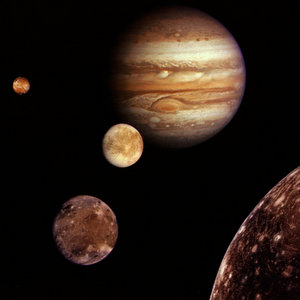Sending a research probe to a planet, asteroid or comet is usually associated with the need to solve the problem of braking – having accelerated along the flight path, the spacecraft spends a lot of fuel to reduce this gained speed without flying past the target or crashing into it. It’s like traveling in a car – when you approach the place of your destination, you slow down and brake beforehand. Except there are no tires or asphalt in space. But there is the dense atmosphere of Jupiter.
With the help of the developed software package, the university scientists laid out the mission routes from Earth to the four largest Jupiterian satellites – Ganymede, Callisto, Io and Europa – and calculated a special aerodynamic braking maneuver that the spacecraft must perform at Jupiter to reduce the speed gained for the trip from Earth. It is proposed to brake with the help of the atmosphere of the giant gas planet – at a certain speed and at a precisely calculated angle, the spacecraft will enter the dense atmosphere of Jupiter, reduce speed to the desired level and then safely “pop out” into the orbit of one or another satellite, depending on the purpose of the mission. The main thing is for the spacecraft not to overheat or burn down due to friction against the atmosphere, and not to collapse from overloads.
“Jupiter and its largest Galilean satellites are of significant scientific interest, and that interest continues to grow. For example, just recently, in April this year an interplanetary station of the European Space Agency JUICE was launched to study Ganymede, Europa and Callisto. An interplanetary flight to Jupiter presents the main problem of the high speed required for the flight itself and for settling into the required orbit in the planet’s activity sphere – a significant fuel reserve for the vehicle’s engines is necessary. We calculated that fuel costs could be reduced by using aerodynamic maneuvering in the dense Jupiterian atmosphere. The reduction in fuel consumption for the entire mission will be from 20 to 40%, depending on the satellite of destination, and this will provide an opportunity to increase the mass of the spacecraft payload,” said Professor Olga Starinova, Head of the Department of Flight Dynamics and Control Systems at Samara University.
According to Olga Starinova, the calculation of such a maneuver is a very complex task; a software package was specially developed to perform calculations and modeling that takes into account multiple parameters of future missions to the satellites of Jupiter. During an aerodynamic braking maneuver in the upper atmosphere, the spacecraft is subjected to overloads that may exceed the maximum permissible values. Moving in the atmosphere also significantly increases the surface temperature of the vehicle, which can lead to heating and failure of the target equipment. Therefore, the modeling of the maneuver was performed with due consideration of the limits of surface heating temperature and maximum overloads.
“The calculation of such a maneuver is one of the most complex scientific and technical tasks in flight dynamics, as it requires taking into account a large number of technical limitations – in terms of maximum spacecraft overload, ram, and limit temperature of the spacecraft surface. The use of additional technical means of circumventing these limitations – for example, the installation of thermal shields or structural strengthening – may result in such an increase in the total mass of the spacecraft that the effectiveness of aerodynamic maneuvering is significantly reduced or even becomes negative. Therefore, we conducted a comprehensive design and ballistic analysis of the use of the aerodynamic maneuver, without narrowing our task down to the mathematical modeling of the vehicle’s motion in the atmosphere of Jupiter,” Olga Starinova explained.
A spacecraft with electric rocket engines was considered as a model for mission routing and maneuver efficiency analysis. The entry angles and depth of immersion into the Jupiterian atmosphere for missions to each of the four Galilean satellites were calculated. The mission to Ganymede appeared to be the most complicated and resource-consuming; to Callisto, the simplest. By the way, the scientists believe that Callisto could become the location of a future space base – this satellite has a relatively low level of radiation compared to the other three Galilean satellites.
For reference:
* Space ballistics is the science of the motion in outer space of various man-made objects. You can study space ballistics at Samara University by enrolling in the specialty “Guided Missile Systems and Astronautics” (bachelor’s degree) or “Design, Production and Operation of Rockets and Space Missile Systems” (specialist degree).
* An aerodynamic maneuver of an aircraft is a change in its speed and/or trajectory due to the atmosphere.
* Jupiter has over 90 satellites. The largest of these are Ganymede, Callisto, Io and Europa, they are called Galilean because they were discovered by Galileo Galilei.
